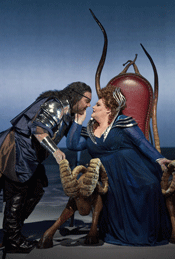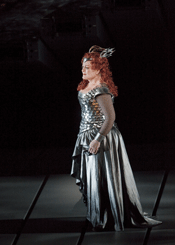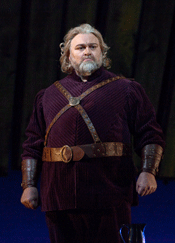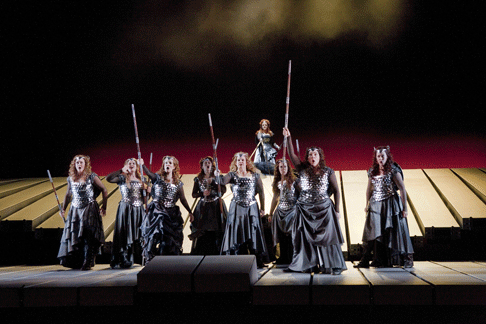If I’d attended the opening, I might have been less pleased. A
friend whom I met at this, the third, performance clued me in on all sorts of
changes, not least in the improving command of his music on the part of Bryn
Terfel. On the third night, there was only one major machinery mishap: Siegrune
(Eva Gigliotti), broke the straps that held her to her bucking
“horse,” and landed with a thump in the trough behind the
forestage. She leaped (nothing broken!) into the wings, and when (after, no
doubt, cursing and moaning mercifully inaudible to us) she bounded back onstage
for a war-cry or two, there was applause. At the Met, audiences take the
singer’s side against malicious, high-concept scenery. This may not be
true at other performing venues.
Die Walk¸re has always been the most popular drama of
Wagner’s Ring, performed far more frequently than the others.
The doomed romance of Siegmund and Sieglinde is the most moving human
relationship in the entire cycle, their undeserved doom winning our deepest
sympathy, and Wotan’s tragedy is nowhere made more manifest than in his
renunciation of Br¸nnhilde, the daughter who has been his second self. Parents,
children, lovers, loners, schemers who fail—everyone who falls into any
of those categories, or sympathizes with one of them, will feel the terrific
pang in Wagner’s matchless musical setting of these situations.
 Bryn Terfel as Wotan and Stephanie Blythe as Fricka
Bryn Terfel as Wotan and Stephanie Blythe as Fricka
The questions I always ask before the curtain rises on Die Walk¸re
are, first, can these singers sing it properly? That is, beautifully,
with enough breath and power for the theater in which they find themselves, and
can they act, so that the lengthy debates of Acts II and III hold our
attention? Then, what pitfalls will the director fall into? Will Siegmund start
fondling Sieglinde the moment he sets eyes on her (which always makes me feel
sympathetic to Hunding) or will their physical communication be only by eyes
and exchanged drinks until their climactic embrace at the end of the act? They
are two people who have never been able to touch anyone all their lives, and
this first contact should mean something, should come only after we know their
stories, anticipate their destinies. Then, how will Br¸nnhilde’s
transformation from unfeeling goddess to sympathetic woman during the
“Todesverk¸ndigung” duet be manifested? And will the director and
the singers be able to make sense of the end of Act II, where Wagner has given
them far too cluttered a set of events to perform? And, last act, lacking real
flying horses and real magic fire, how will they indicate flying horses and
magic fire?
A great deal of the answer in the Met’s new production, by Robert
Lepage, depends on special mechanical effects created by lights, projections
and twenty-four “planks” that perform as athletically as anybody.
You may remember them from Das Rheingold, as the roof of
Alberich’s cavern and the staircase down to it from Valhalla, the bridge
towards that castle and its monumental walls as well. This time around, the
planks portray the rustic insides and (later) the slate roof of Hunding’s
hut, a snowcapped mountain (getting all the icier with Wotan’s chilly
mood), eight cavorting steeds in the Valkyrie Theme Park™, a tulgy wood
or two, heaving in the wind, and a stage-wide winged bird-beast of prey. They
are also the plasma-screen projection TV of Siegmund’s bardic
imagination, and that’s going entirely too far—savages racing about
like animated cave paintings are mere kitsch and as unnecessary as subtitles.
Just listen to the leitmotifs and Wagner will tell you exactly
what’s going on. Lepage also provides a gigantic plastic eyeball
(programmed for light show!) to illustrate Wotan’s narration, and a
spectacular ram’s head-armed High Victorian settee for Fricka, but rarely
did I feel in Act II (as I had with the cave paintings) that he had gone too
far, illustrating what simply did not call for illustration. Many of the
meditative sections of Wagner’s great drama were indeed meditative: The
music, the singing, needed no specific illustration because the music, the
singing, were the drama, and what it was about. I wasn’t sure Lepage had
got that important Wagnerian memo; perhaps he has.
Was Lepage or some less exalted figure responsible for the moving around of
the humans in this staging? Someone has paid attention to the psychological
underpinnings of the drama, which is an excellent thing. Though there are
certain things I itch to tweak, in many ways it is an improvement on earlier
stagings, even the sacrosanct Schenk production. Siegmund’s rush through
the forest (those planks again!) was quite alarming, and can’t be easy to
render safe. It will also exhaust the average tenor, but then, he has a time to
catch his breath before singing again, and he spends it lying across the
Hundings’ hearth. Sieglinde, who has been out gathering wood, finds him
there and touches him, gingerly, to see if he’s still alive. At this,
Siegmund seizes her hand—plainly the reflex of a hunted man and no
flirtation. Later, Hans-Peter Kˆnig—not merely a bass of golden age vocal
stature, who only has to open his mouth to remind us how fallen, in other
categories, is the modern Wagnerian estate, but also the funniest Hunding
ever—ambles brutally home, tosses his bearskins on the sword-hilt
conveniently sticking out of a tree, and, without looking at him, sticks his
spear across the stranger’s chest as if to say, “What the hell is
he doing here?” The focus on the scene that follows is,
correctly, not on Siegmund so much as on the portrait of an unhappy marriage
that Siegmund has interrupted.
 Deborah Voigt as Br¸nnhilde
Deborah Voigt as Br¸nnhilde
I’ve always hated the salacious impulse of modern directors to have
Siegmund and Sieglinde flop down and do it on the kitchen floor as the curtain
falls on Act I. Surely she loathes her unhappy home, Hunding might wake at any
moment, and Siegmund’s whole message has been: There’s a great big
world full of springtime and love out there! Let’s go and enjoy
it! Wagner says they rush out into the night, and I’m with him. So,
happily, is Lepage, for as we watch, the planks that have been the inner wall
of Hunding’s hut turn into the slate roof, and we’re out in the
woods. Excellent.
In Act II, the planks became a sort of mountain platform with a cavern
beneath, and on this floated Stephanie Blythe, our Fricka. Though sizable,
Blythe has never had the slightest difficulty racing about the stage and up and
down reasonable obstacles, but Lepage has not been willing to risk this. He
gives her a motorized wheelchair with rams’ heads on the arms (in Norse
mythology and in Wagner’s text, Fricka drives a chariot drawn by rams),
and here she must sit and discourse with Wotan. Being Blythe, she has no
problem acting in this contraption: seething goddess, neglected wife, yearning
erstwhile lover, implacable lawyer (G.B. Shaw said Fricka represented the Law
to Wotan’s Church). I found rather touching her extension of a hopeful
hand to defeated Wotan, and his sarcastic kissing of it. The next
“effect” was the popping up from the cavern under the rocks (the
planks again) of a circular plastic “eye,” a screen on which
Br¸nnhilde watches suggestive videos while Wotan tells her his tale. Cute but
kitsch, and unnecessary.
For the Todesverk¸ndigung, we were back in plank forest, but nothing much
should happen during Siegmund and Br¸nnhilde’s stichomythia, at
least until its conclusion, when he takes up the sword to slay Sieglinde and
Br¸nnhilde, in stopping him, unknowingly becomes human herself. Here Deborah
Voigt abruptly deflected his blade with her shield, and disarmed him with her
spear. It was startling, as the moment should be.
I’ve rarely seen the scene that ends Act II staged with all its
elements clear and visible, gods “hovering” protectively over
mortals, a lot of weapons-play, witnesses to things incomprehensible if not
invisible. And how many Br¸nnhildes can pick up all the pieces of broken
Nothung and get Sieglinde offstage in the allotted time? Lepage managed most of
it to a thrilling degree. Hunding and his men simply did not “see”
Wotan or Br¸nnhilde; nor, so far as we could tell, did Sieglinde, motionless
until the moment Br¸nnhilde (whom she has never seen before, remember)
addressed her. Wotan strode forward with his spear to break the useless sword
in Siegmund’s hand, then stood back to allow Hunding to strike the death
blow. Siegmund died cradled in Wotan’s arms, reaching, touchingly, to the
face of the invisible father he has barely known. Then—a little too
hurriedly, methinks; he should have godlike dignity even in his
wrath—Wotan chugged off stage in pursuit of his errant daughters. It
seemed to me that there were far too many men around, Hunding’s
confederates but, in fact, Lepage’s crew. There is nothing for them to
do, no reason for them to move, and they neither moved nor sang. Two or three
would fill the bill.
And so to the scene that is usually a snap: Wotan kisses Br¸nnhilde, her
godhead falls away, she sinks sleeping into his arms, and he lays her out on
the mountaintop before summoning the fire to surround her. Here, Lepage let his
ambitions for a startling tableau run away with him, adding many an unnecessary
complication in order to produce an image that, while impressive, even
chilling, hardly seemed worth the bother. We should focus on Wotan and his
feelings (lovingly described by the orchestra); instead we are distracted by
the sight of the snow-covered mountain sinking into the earth, the
spear-cradled Valkyrie (a body double) carried to the top of it and hung upside
down as we, presumably, witness from above, in dolly shot. It’s quite a
coup de thÈ‚tre, but aren’t we attending an opera? Shouldn’t the
emotional focus of the story be Wotan’s feelings, and not: How does she
stay up there?
The singing ranged from good to spectacular—alas, the best of it came
from the two least loved of the figures onstage, Fricka (Stephanie Blythe),
rock solid but warm and womanly, and Hunding (Hans-Peter Kˆnig), who opens his
mouth only to caress the ear, reminding one of Kurt Moll, Matti Salminen and
the other Wagnerian basses of more golden ages. The weakest link was Sieglinde,
Eva-Maria Westbroek, a handsome woman and a fine actress with a large, womanly
instrument, who sang “Du bist der Lenz” consistently flat and her
final triumphant outburst in Act III all over the place, never consistently
anything or anywhere. She’d been suffering from a cold a week before, at
the opening; perhaps it lingered, unannounced. In any case this was not an
enjoyable Sieglinde.
 Hans-Peter Kˆnig as Hunding
Hans-Peter Kˆnig as Hunding
At my first Die Walk¸re (Nilsson, Jones, Vickers), forty years ago,
a veteran of many Rings beside me turned to her friend and said, “Such a
pleasure to see a Siegmund and Sieglinde who actually resemble each
other.” I think Vickers wore a blond wig, actually. At this latest one,
Westbroek and Jonas Kaufmann seemed to be wearing curly chestnut wigs—in
any case, the resemblance of these tall, slim persons in dark garb (especially
when they first warily looked each other over, profile echoing profile) was
striking enough to seem uncanny, as Wagner desired—score for the
Met’s wig and makeup department! Kaufmann, currently one of the
world’s most admired tenors but one whose voice had seemed a little small
for the Met even against a Traviata orchestra, gave us a darkly
baritonal, cautious Siegmund, meeting nearly all the role’s challenges
with full weight. The “W„l-” in his Act I-concluding
“W‰lsungen Blut” was flat, as if his strength had given out by that
time, but the invocations of “W‰lse” earlier in the act were
stirringly done. He seemed to have the measure of the Met’s acoustics and
to know just how far he did not need to push to be heard in a suave
“Winterst¸rme” and the ominous phrases of the Todesverk¸ndigung.
His ability to race through quite a dangerous little maze of log palisade/thick
forest, to fight almost credibly with a broad sword and to die with an
anguished gaze on the father-god who has betrayed him won him a deserved
ovation.
I’d been dreading Deborah Voigt’s assumption of the role of
Br¸nnhilde, and I still wish they’d find someone else for it, but she
managed a decent, B-level Valkyrie, devotedly acted, and she looked terrific in
a costume carefully modeled on the Victorian armor and silken flounces of
Amalie Materna’s creation of the role at Bayreuth in 1876. She brought
the proper emotions to her singing, the exultation to the war-cry (no trills of
course), a sense of inexorable doom to the all-important Todesverk¸ndigung. But
Voigt’s voice these days suggests little in the way of color, of metal,
of shine; half the time she scrapes it over gravel. It is the ruins of a voice
and therefore, though she gives an enthusiastic performance, it does not sound
heroic. This is less painful in the long, narrative stretches of a Wagnerian
part than it was in lyric Puccini last December, when she was simply a gray,
blank space on a colorful canvas; in Wagner she is able but uninspiring.
Bryn Terfel seemed inadequate to Wagnerian power in Das Rheingold
last fall, but either his health has improved or he has devoted more attention
and energy to the far longer and emotionally deeper Wotan of Die
Walk¸re. There were moments (such as the beginning of his Act II
narration) where his bad habit of acting, spitting, thrusting lines rather than
singing them proved briefly tiresome, but by and large this was an honest,
forceful, intriguing performance, one that holds proper weight in the opera,
with real lyricism when he dwelt on the springlike love of the twins or his
youthful ambitions, and in the long last exchange with the desperate
Br¸nnhilde. His diction was excellent, he never fell back to crooning as he has
been known to do when singing Mozart. His acting was full of intriguing
touches, like the unloving kiss he forces himself to place on Fricka’s
outstretched hand, nor did the wobbling planks beneath his feet give him the
slightest insecurity. He played an imposing if unlucky king of the gods with
conviction and authority.
 A scene from Act 3 of Wagner’s “Die Walk¸re” with the Valkuries (left to right) Marjorie Elinor Dix as Waltraute, Wendy Bryn Harmer as Ortlinde, Molly Fillmore as Helmwige, Kelly Cae Hogan as Gerhilde, Mary Ann McCormick as Grimgerde, Lindsay Armann as Rossweisse, Eve Gigliotti as Siegrune, and Mary Phillips as Schwertleite. At top is Deborah Voigt as Br¸nnhilde.
A scene from Act 3 of Wagner’s “Die Walk¸re” with the Valkuries (left to right) Marjorie Elinor Dix as Waltraute, Wendy Bryn Harmer as Ortlinde, Molly Fillmore as Helmwige, Kelly Cae Hogan as Gerhilde, Mary Ann McCormick as Grimgerde, Lindsay Armann as Rossweisse, Eve Gigliotti as Siegrune, and Mary Phillips as Schwertleite. At top is Deborah Voigt as Br¸nnhilde.
James Levine was too weary to climb up to the stage at the end of the
festivities; the singers applauded him from the stage apron. Other indications
that he has changed were apparent. For one thing, he kept the surge of
Wagnerian power at a low simmer: His singers never had to fight to be heard.
This is new. Perhaps it was a concession to the less than godlike power of
Kaufmann and Voigt, but Levine has never made such concessions before; he has
usually been a conductor you had to fight for stage attention. Many a glorious
note has risen clear and singing over the years to the front regions of the top
balconies of the Met’s horseshoe, inaudible in the orchestra seats. If
this was a new control, a new generosity, it was very pleasing in Row M. If
there was less of an emotional swell to the final parting of Wotan and
Br¸nnhilde than one likes to feel, let’s be generous and credit the
awkward new staging. But I’m strongly tempted to go to another
performance, somewhere high in the Family Circle, to check my perceptions of
the Wagnerian temperature, usually at white heat in those polar regions.
If the new Rheingold made one wonder about the Met’s
priorities and the advisability of the entire endeavor, the new
Walk¸re makes me look forward with interest to the remainder of the
cycle.
John Yohalem
image=http://www.operatoday.com/Wulkure_Met_2011_01.gif
image_description=Jonas Kaufmann as Siegmund and Eva-Maria Westbroek as Sieglinde [Photo by Ken Howard courtesy of Metropolitan Opera]
product=yes
product_title=Richard Wagner: Die Walk¸re
product_by=Br¸nnhilde: Deborah Voigt; Sieglinde: Eva-Maria Westbroek; Fricka: Stephanie Blythe; Siegmund: Jonas Kaufmann; Wotan: Bryn Terfel; Hunding: Hans-Peter Kˆnig. Production by Robert Lepage. Metropolitan Opera Orchestra conducted by James Levine. Performance of April 28.
product_id=Above: Jonas Kaufmann as Siegmund and Eva-Maria Westbroek as Sieglinde
All photos by Ken Howard courtesy of Metropolitan Opera